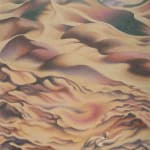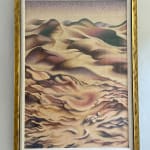Henry Orlik b. 1947
Framed: H. 82 cm. x W. 60 cm., H. 32½ in. x W. 23½ in.
Further images
Escape II is a landscape of sand dunes in which Orlik shows his skill as a colourist. In the far landscape (top half of the painting), he uses soft reds and purples, warm, gold sand-colours and charcoals to mass the shapes and shadows of the dunes, the depths, the meandering rolling ups and downs, crevices and highlights. The organic shapes he creates are suggestive of the human body and limbs and possibly the wings of birds. The painting evokes Orlik’s beautiful pencil drawing, Dunes, in which he seems to be ‘working out’ and playing with the folds and shapes of the land which become reminiscent of so many of the suggestive anthropomorphic motifs that he uses in his landscapes, such as elements of the human bodyand fish tails.
From the centre of the painting downwards, the shapes become more intense, almost sea-like,as the land seems to teem and undulate. ‘Swimming’ strongly and doggedly, or crawling, through the desert is a figure which appears to carry a gun under his arm. He stretches out with one arm, his head lowered as he tries to make his progress through the sand-quagmire. Two ‘tails’, like fishes or serpents, seem to swish out behind and to the side of him, suggesting that he is being followed, unwittingly maybe, by an unknown predator beneath the surface.
Orlik directs the viewer with the specific titles that he chooses for his paintings. Escape II, therefore, relates to Escape, in which a bird/fish flies above a city – a desert city perhaps - which is painted in the same ‘sand’ colours as the landscape in Escape II. In Orlik’s imagination, therefore, perhaps Escape II is after the city in Escape has been swallowed by the desert and a lone figure is trying to escape from the desert-sea which has engulfed it. Here, however, the figure’s escape becomes physical rather than metaphysical, as he strikes out through the land-sea. The landscape has become a physical landscape but is still a psychological landscape and the ordeal that the figure faces to escape is immense - both physical and mental. As the figure has a gun, it suggests the struggles that dispossessed people faced in Europe during and after the Second World War which affected Orlik’s displaced parents during Nazi and then Soviet occupations.
This brings to mind Frank Herbert’s Dune Chronicles (and the films and spin-off TV series), one of the world’s best-selling science fiction novels first published in 1965, set on an inhospitable planet which is a desert wasteland. In 1957, after the publication of his novel The Dragon in the Sea, Herbert went to the Oregon Dunes where the US Department of Agriculture was attempting to use poverty grasses to stabilize the sand dunes. Herbert claimed in a letter that the moving dunes could ‘swallow whole cities, lakes, rivers, highways’. This sparked Herbert’s interest in the ecology of deserts. His article on dunes, ‘They Stopped the Moving Sands’, was published decades later in The Road to Dune. Dune has been called the ‘first planetary ecology novel on a grand scale’. (Edward Jamesand Farah Mendlesohn (2003), The Cambridge Companion to Science Fiction, 2003, pp. 183-184). After the publication of Rachel Carson’s Silent Spring in 1962, science fiction writers began writing about the subject of ecological change and its consequences. The depiction ofa planet as a complex, living, being allies strongly with Orlik’s anthropomorphic landscapes and his idea of Mother Earth and the connection of all living things through shared atomic quantums.










